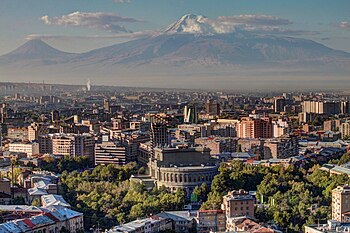Every time I get ready to do a new country, I usually take a
look at my pre-knowledge. What do I already know about this country? Well, for
one, I had the location wrong (yes, it’s rare, and I’m embarrassed to admit
that.). The only other thing I had going for me was that their language was
also called Armenian. So, I had a LOT of learning to do.
First of all, Armenia is located in the northern part of the
Middle East, by Turkey and north of Iran – not in southern Europe like I had
previously thought. It’s also bordered by the countries of Georgia and
Azerbaijan. Armenia is also the
home of the famous Mt. Ararat – you know, like where Noah’s ark landed after
the flood. In fact, the word for “Armenia”
in the Armenian language is Hayk (sometimes called Hayastan), which is named
after the great-great-grandson of Noah. The name “Armenia” itself is thought to
have ultimately come from the Greek.
Armenia prides itself for being the first country to declare
Christianity as its official religion, since about the 4th century.
(This is even before the Roman Empire did! Take that, Romans.) In fact, one monk and linguist by the
name of St. Mesrob Mashtots (awesome name) was the one who created the Armenian alphabet,
which was one of the key things that helped to develop the Armenia kingdom and
its standing as its own independent government. The Armenian language itself, while
similar to other languages spoken in nearby cultures, is linguistically in a
category on its own and belongs to no specific language branch. (Sort of like
the Albanian language.) St. Mesrob is considered one of the Holy Translators of
Armenia. (I didn’t even know that was a valid position. Wonder if I could
apply… I thinking I may not get it simply because I’m 1) not holy, 2) not a
translator, and 3) not Armenian. But stranger things have happened.)
The country itself has a fairly high rate of sanitation and
clean water, as well as literary rates. However, the country has taken an
economic downturn in the past decade: Armenia is #1 in the world in
unemployment of 15-24 year olds at 57.6%. In comparison with the United States,
the unemployment rate for 15-24 year olds is only 17.6%. Overall though, the
unemployment rate is around 5.9%, compared with the United States, which is
around 9.1%. Initially what this says to me is that they have more adults
working rather than high-schoolers and young adults, who are more than likely
attending school during these years. Whereas you’ll find in the United States,
there is more of a push to have younger workers while in school. But there may
be other factors I’m not aware of as well.
For much of the 20th century, Armenia was part of
the communist Soviet Union. Even though Yerevan has been the capital of the
Republic of Armenia since 1991 (starting with the fall of the Soviet Union),
there are still many remnants of the Russian influence on the city, country,
and its people. In fact many people still insist their kids learn Russian as a
second language.
The capital city is Yerevan and Armenia’s largest city. It’s
considered one of the oldest continuously inhabited cities in the world
(Damascus, Syria is the oldest), showing evidence that people have lived there
since around 800 BC. Today, Yerevan has about 1.1 million people living there,
almost as many as Indianapolis, Indiana. In fact, the city just earned cool
points in my book since they were named 2012 World Book Capital, an honor
designated by UNESCO to certain capital cities that stress an importance in
books, reading, and literacy programs aimed at not only local levels but also
international levels as well. (The cynic in me was saddened but not surprised
that Washington, D.C. hasn’t made the list yet; but when you have lawmakers
promising to cut the entire Dept of Education, I don’t see World Book Capital
happening anytime soon, unfortunately.)
While the area may have been controlled by a plethora of
ruling parties and have changed hands many times in its history, Armenians
strive to maintain their own identity throughout all of this and are proud of
what is Armenian. Even if it means parts have been borrowed here and
there. Like its language, their
culture may be similar to nearby cultures, but it is indubitably and
irrevocably Armenian.
Next up: Holidays and Celebrations
Resources:
CIA World Factbook: Armenia
Wikipedia: “Armenia” “List of country-name etymologies” “Saint
Mesrob” “Yerevan”
National Geographic.com




No comments:
Post a Comment